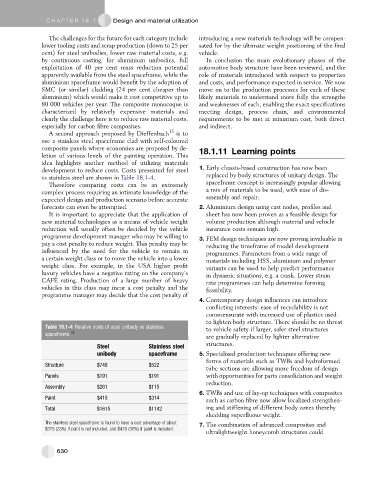Page 619 - Automotive Engineering Powertrain Chassis System and Vehicle Body
P. 619
CHAP TER 1 8. 1 Design and material utilization
The challenges for the future for each category include introducing a new materials technology will be compen-
lower tooling costs and scrap production (down to 25 per sated for by the ultimate weight positioning of the final
cent) for steel unibodies, lower raw material costs, e.g. vehicle.
by continuous casting, for aluminium unibodies, full In conclusion the main evolutionary phases of the
exploitation of 40 per cent mass reduction potential automotive body structure have been reviewed, and the
apparently available from the steel spaceframe, while the role of materials introduced with respect to properties
aluminium spaceframe would benefit by the adoption of and costs, and performance expected in service. We now
SMC (or similar) cladding (24 per cent cheaper than move on to the production processes for each of these
aluminium) which would make it cost competitive up to likely materials to understand more fully the strengths
80 000 vehicles per year. The composite monocoque is and weaknesses of each, enabling the exact specifications
characterized by relatively expensive materials and meeting design, process chain, and environmental
clearly the challenge here is to reduce raw material costs, requirements to be met at minimum cost, both direct
especially for carbon fibre composites. and indirect.
A second approach proposed by Dieffenbach 15 is to
use a stainless steel spaceframe clad with self-coloured
composite panels where economies are proposed by de- 18.1.11 Learning points
letion of various levels of the painting operation. This
idea highlights another method of utilizing materials
development to reduce costs. Costs presented for steel 1. Early chassis-based construction has now been
vs stainless steel are shown in Table 18.1-4. replaced by body structures of unitary design. The
Therefore comparing costs can be an extremely spaceframe concept is increasingly popular allowing
complex process requiring an intimate knowledge of the a mix of materials to be used, with ease of dis-
expected design and production scenario before accurate assembly and repair.
forecasts can even be attempted. 2. Aluminium design using cast nodes, profiles and
It is important to appreciate that the application of sheet has now been proven as a feasible design for
new material technologies as a means of vehicle weight volume production although material and vehicle
reduction will usually often be decided by the vehicle insurance costs remain high.
programme development manager who may be willing to
3. FEM design techniques are now proving invaluable in
pay a cost penalty to reduce weight. This penalty may be reducing the timeframe of model development
influenced by the need for the vehicle to remain in programmes. Parameters from a wide range of
a certain weight class or to move the vehicle into a lower materials including HSS, aluminium and polymer
weight class. For example, in the USA higher profit variants can be used to help predict performance
luxury vehicles have a negative rating on the company’s in dynamic situations, e.g. a crash. Lower strain
´
CAFE rating. Production of a large number of heavy rate programmes can help determine forming
vehicles in this class may incur a cost penalty and the feasibility.
programme manager may decide that the cost penalty of
4. Contemporary design influences can introduce
conflicting interests: ease of recyclability is not
commensurate with increased use of plastics used
to lighten body structure. There should be no threat
Table 18.1-4 Relative costs of steel unibody vs stainless to vehicle safety if larger, safer steel structures
spaceframe. 15
are gradually replaced by lighter alternative
structures.
Steel Stainless steel
unibody spaceframe 5. Specialized production techniques offering new
forms of materials such as TWBs and hydroformed
Structure $748 $522
tube sections are allowing more freedom of design
Panels $191 $191 with opportunities for parts consolidation and weight
reduction.
Assembly $261 $115
6. TWBs and use of lay-up techniques with composites
Paint $415 $314
such as carbon fibre now allow localized strengthen-
Total $1615 $1142 ing and stiffening of different body zones thereby
shedding superfluous weight.
The stainless steel spaceframe is found to have a cost advantage of about 7. The combination of advanced composites and
$375 (23%) if paint is not included, and $475 (30%) if paint is included.
ultralightweight honeycomb structures could
630

